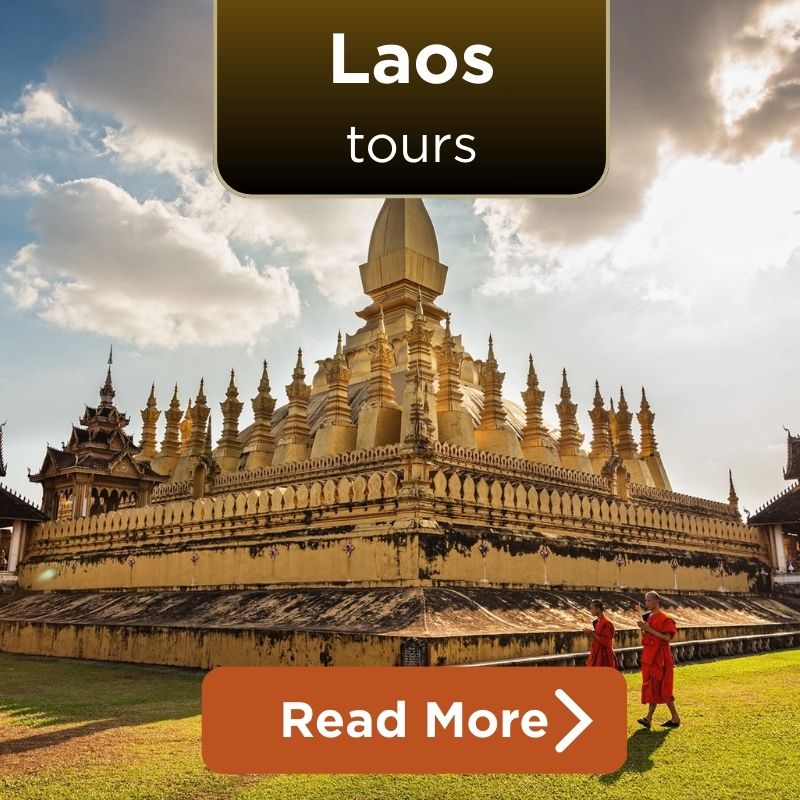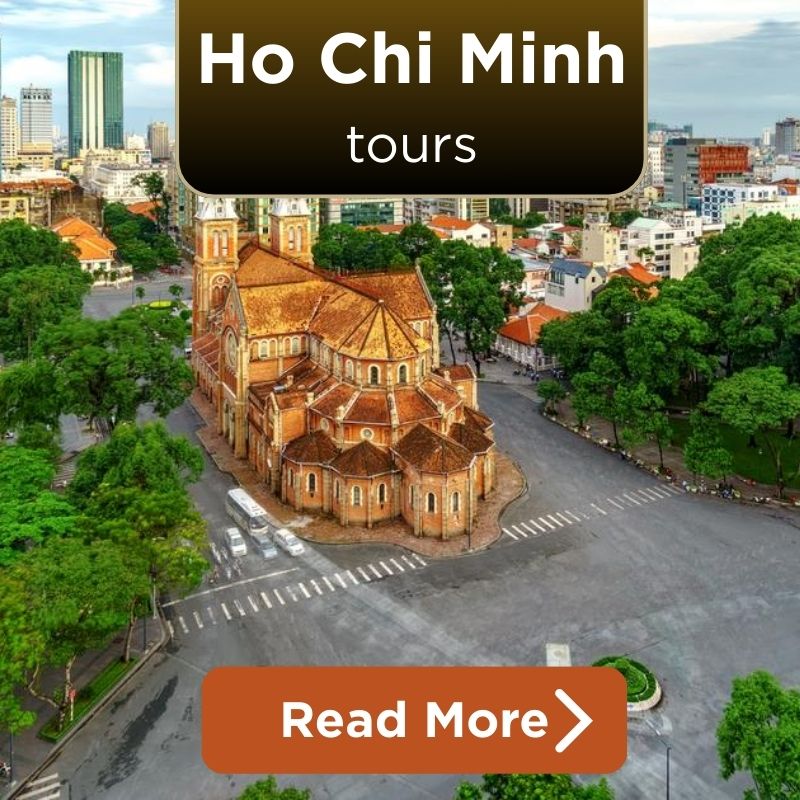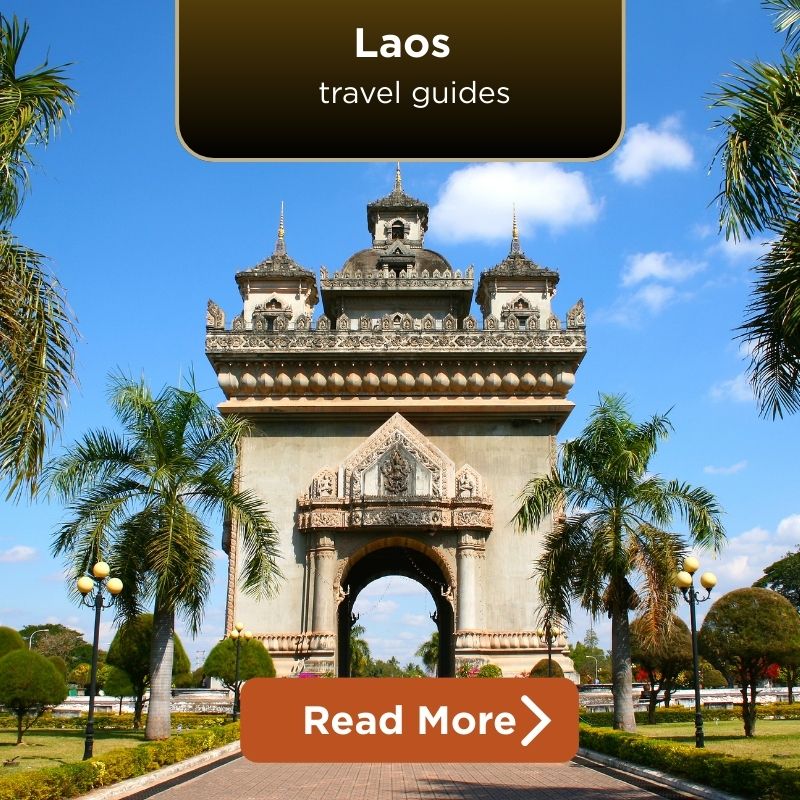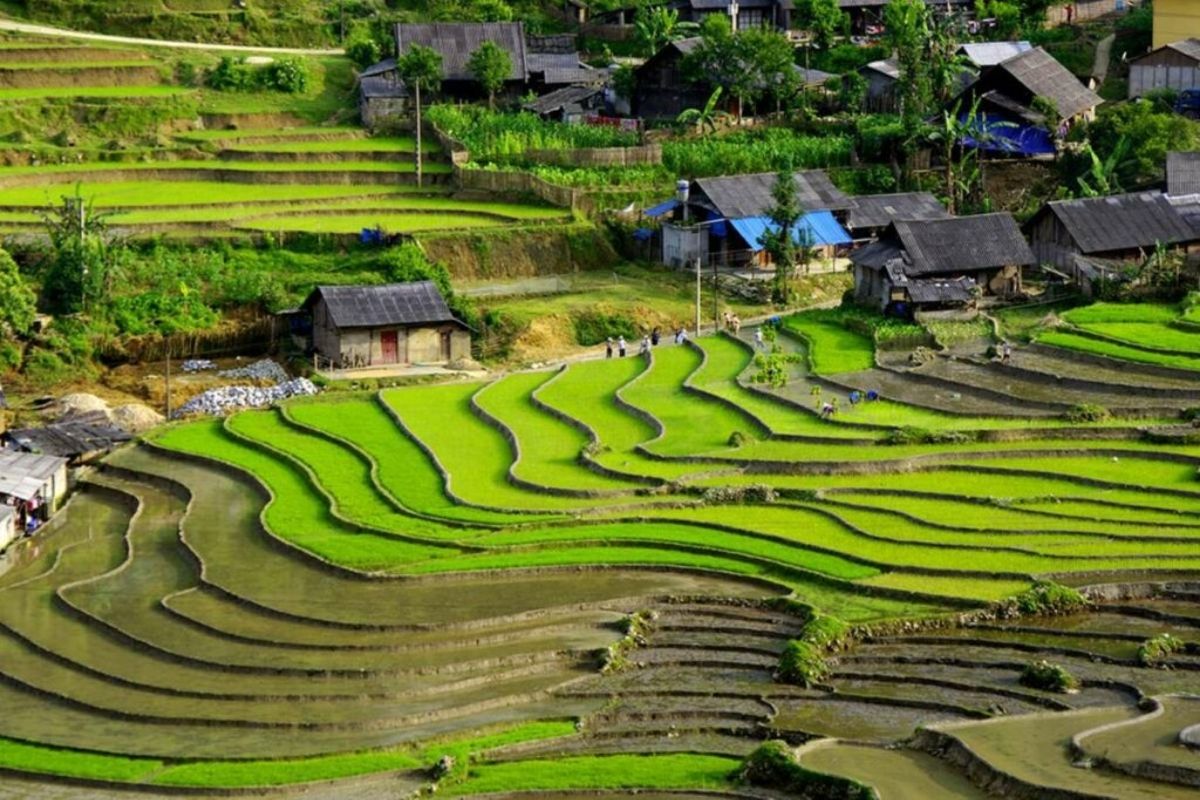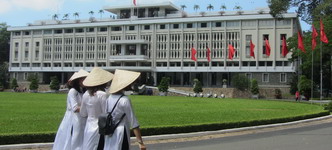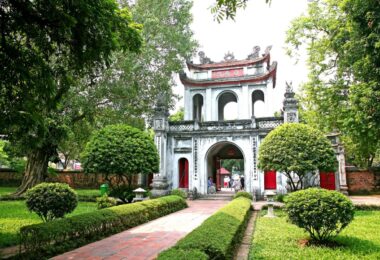Where Is Hanoi’s Chinatown Located? Complete Visitor Guide
Geographical Location: Where Exactly is Hanoi’s Chinatown?
Hanoi Chinatown is situated to the north of the Hanoi Old Quarter, inside the historic Hoan Kiem District of Hanoi. The district is developed around four principal streets, with their individual charm and historical character:
- Hang Buom Street Hanoi:
- Location: From Dao Duy Tu Street to the intersection at Hang Ngang, Hang Duong, and Lan Ong Streets.
- Highlights: Houses the historic Quang Dong Assembly Hall at 22 Hang Buom. It is also noted for Chinese-style roast meat shops, old-style candy shops, and lively street stalls.
- Notable Places: Bach Ma Temple (76 Hang Buom), Hanoi’s One of the four sacred temples, and many traditional Chinese medical shops.
- Hang Ngang Street:
- Location: It joins Hang Dao Street and proceeds towards Hang Buom.
- Historical Significance: Renowned for the 48 Hang Ngang House, where the Declaration of Independence of Vietnam was written in 1945 by President Ho Chi Minh.
- Shopping and Dining: Traditionally, a thriving silk market, shops now line the area selling souvenirs, cloth, and traditional Chinese herbal remedies.
- Lan Ong Street (Fujian Street):
- Location: From the intersection of Hang Duong and Hang Can to Hang Bo Street.
- Specialty: Nicknamed the Herbal Medicine Street, this road is lined with stores selling traditional Chinese medical herbs and traditional remedies.
- Notable Landmark: Fujian Assembly Hall (Hoi quan Phuc Kien), heritage site containing Chinese architecture and cultural heritage.
- Phuc Kien Street (Lan Ong Street):
- Location: From Hang Can Street to Thuoc Bac Street.
- Historical Background: Formerly a center for the Chinese people of Fujian Province, the area is to this day characterized by Chinese architectural elements and traditional stores.
- Key Features: Ancient temples, herbal medicine shops, and traditional Chinese-style architecture.
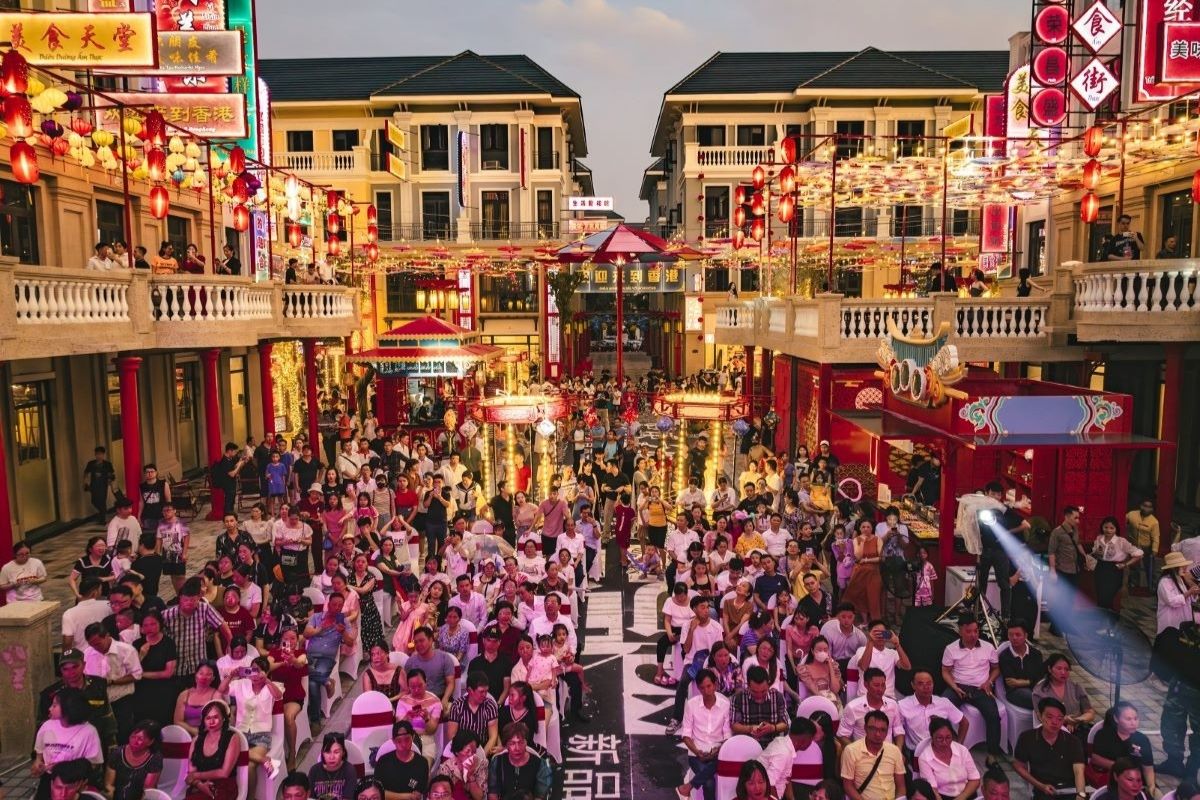
Hanoi Chinatown (Source: datvietgroups)
How to Get to Hanoi Chinatown: Detailed Directions
It is easy to visit Hanoi Chinatown since it is located in the center of the Hanoi Old Quarter. The most convenient options for visiting this cultural center are:
Option 1: Walking from Hoan Kiem Lake or Hanoi Downtown
- Starting Point: Hoan Kiem Lake (Dinh Tien Hoang Street).
- Route: Walk along Hang Dao Street to Hang Ngang, keep going straight to Hang Buom. The walking time is about 10-15 minutes.
- Recommended for: Travellers who are keen to experience the vibrant atmosphere of the Hanoi Old Quarter.
Option 2: Public Transport (Bus and Taxi)
- By Bus:
- Bus Route 09: From Hoan Kiem Lake, alight at Dong Xuan Market, and walk to Hang Buom Street Hanoi.
- Bus Route 14: From Hanoi Opera House, alight at Long Bien, then proceed on foot to the area around Lan Ong Street.
- Bus Fare: Usually 7,000 VND per ride.
- By Taxi or Ride-Hailing Apps (Grab, Gojek):
- Fare Range: 20,000 – 50,000 VND, based on where you’re beginning
- Travel time: Approximately 5-10 minutes from Hanoi Downtown, depending on traffic conditions.
- Recommended for: People who like getting to their destination quickly but comfortably.
Option 3: Guided Walking Tour
- Best for First-Time Visitors: Take a guided walking tour exploring the historical past and cultural heritage of Hanoi Chinatown along Hang Buom, Hang Ngang, Lan Ong, and Phuc Kien Streets.
- Where to Book: Impress Travel (125 Hoang Ngan, Trung Hoa, Hanoi, Vietnam, Phone: +84 912 379 189
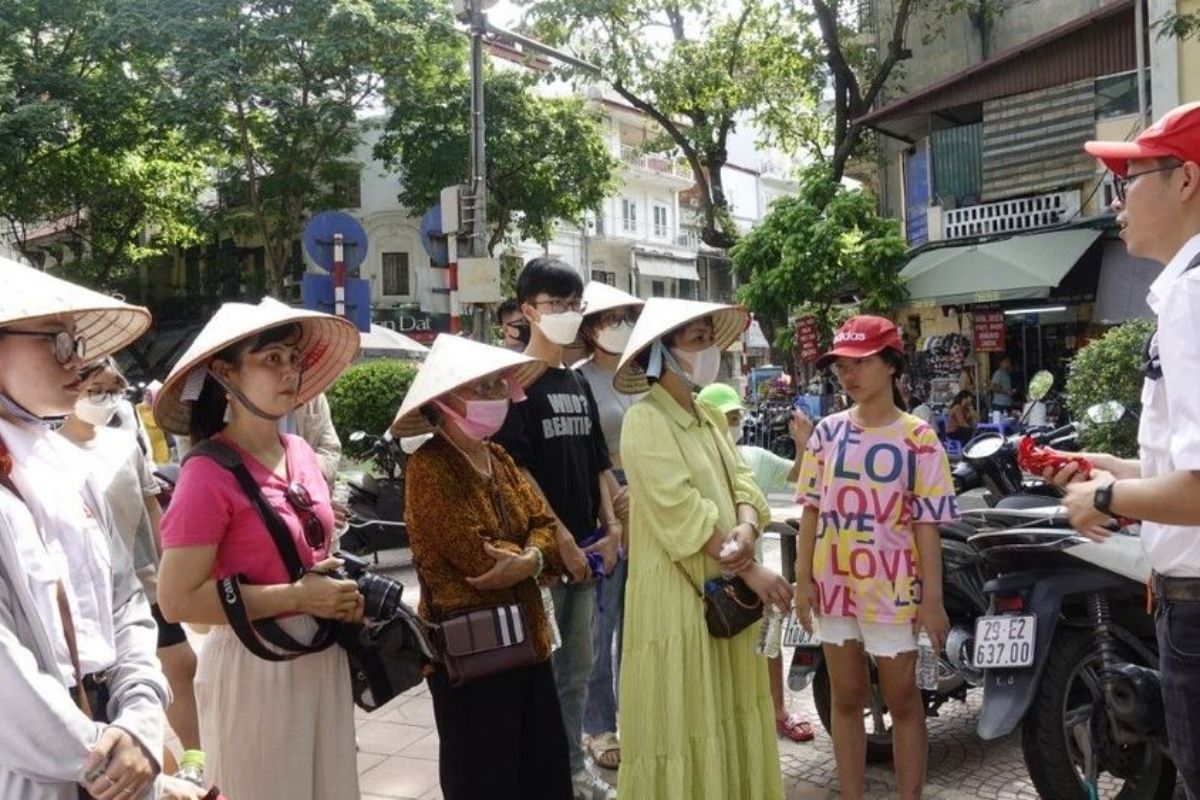
Guided Walking Tour (Source: sightseeing)
The History of Hanoi Chinatown: A Journey Through Time
The Early Origins of Hanoi Chinatown
Hanoi Chinatown was established in the 17th century with the settlement of Chinese people from Guangdong and Fujian in Hang Buom Street Hanoi, Hang Ngang, Lan Ong, and Phuc Kien (Lan Ong) streets. The settlers, who included merchants, herbalists, and artisans, converted the area into a thriving business center. Some of the settlers established assembly centers such as the Quang Dong Assembly Hall (22 Hang Buom), while they set up Lan Ong Street to function as a hub for traditional Chinese herbal medicine, establishing a cultural enclave in the core of Hanoi 36 Streets.
French Colonial Era: Transformation and Resilience
The coming of the French in the late 19th century greatly transformed Hanoi Chinatown. The streets also changed their names to comply with French influence – Hang Buom became Rue des Voiles, Hang Ngang was Rue des Cantonais. The Chinese people, even under French occupation, managed to keep their cultural identity intact through temples, assembly halls, and traditional rituals. The region was still a hub of trade, where merchants traded in silk, herbs, and Chinese exports, while the sacred places like the Quang Dong Assembly Hall and Bach Ma Temple retained their cultural importance.
Modern Transformation: Decline and Revival
Following the independence of Vietnam in 1954, some Chinese residents departed Hanoi Chinatown, but the cultural heritage of the area remained intact. The Quang Dong Assembly Hall and the Fujian Assembly Hall on Lan Ong Street were kept intact, but Hang Buom Street in Hanoi had become a thriving food street, famous for roast meat, herbal soups, and a Chinese-influenced banh mi. Hanoi Chinatown today is a bustling tourist area in Hanoi Downtown where old tradition meets modern shops and restaurants, providing a special cultural experience.
What to Do in Hanoi Chinatown: A Complete Visitor Guide
Food and Drink Experiences: A Culinary Adventure
Hanoi Chinatown is a food heaven, where the luscious taste of Chinese cuisine is perfectly synchronized with local taste buds. Here are the food activities you should not miss:
- Roast Pork and Chinese Roast Meat:
- Where to Try: Minh Ky Roast Meat Shop, 72 Hang Buom Street Hanoi.
- What to Expect: Crispy-skinned roast pork, roast duck, and char siu pork, accompanied with aromatic rice or soft noodles.
- Price: 70,000 – 150,000 VND per serving.
- Dim Sum Delights:
- Where to Try: Little Hong Kong (75 Hang Buom Street Hanoi).
- What to Expect: Steamed dumplings, pork buns, spring rolls, and shumai served hot right from bamboo baskets.
- Price: 40,000 – 80,000 VND per plate.
- Herbal Soups and Chinese Medicinal Cuisine:
- Where to Try: Thien Phu Herbal Cuisine (Lan Ong Street, Hanoi Chinatown).
- What to Expect: Nutritious soups based on Chinese herbs such as ginseng, goji berries, and dry mushrooms.
- Price: 80,000 – 200,000 VND per
- Banh Mi with a Chinese Twist:
- Where to Try: Banh Mi Lan Ong (50 Lan Ong Street, Hanoi Chinatown).
- What Makes It Special: A special twist on the classic banh mi is the crispy baguette paired with roast pork, pickled vegetables, and a drizzle of Chinese five-spice sauce.
- Price: 25,000 – 40,000 VND per
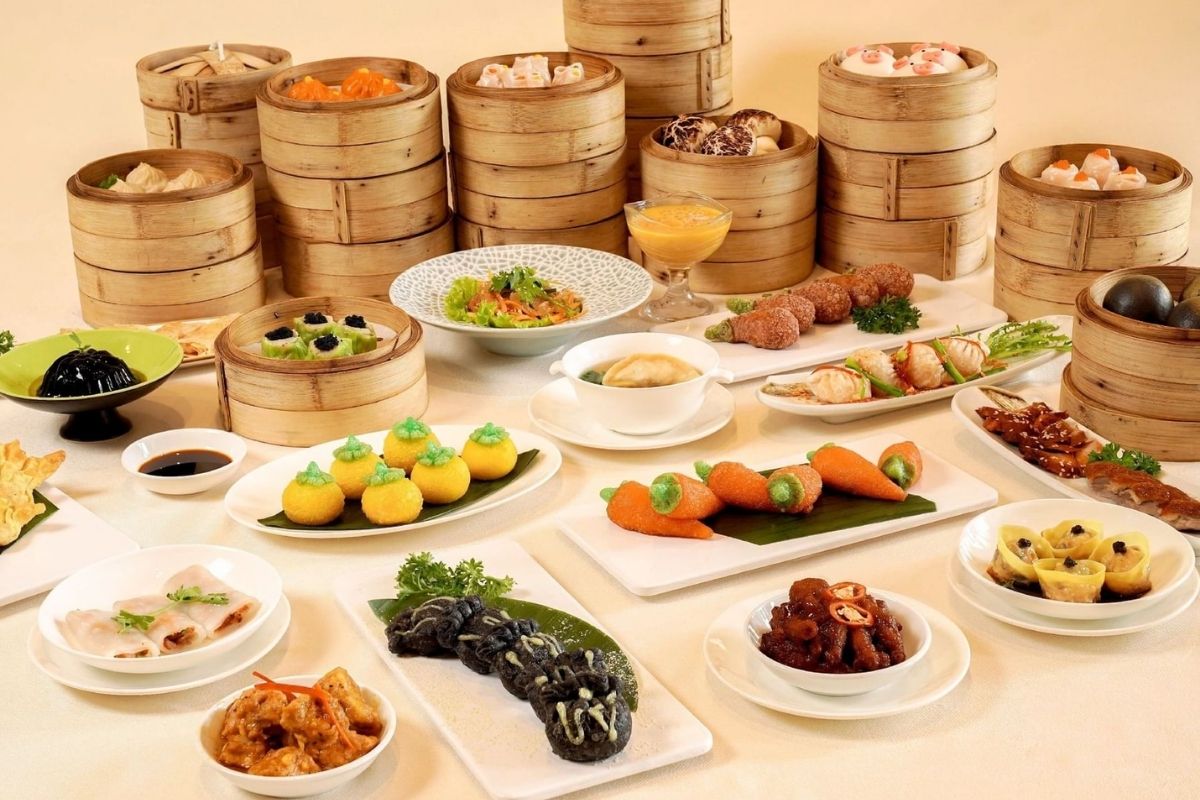
Dim Sum Delights (Source: skylightnhatrang)
Cultural Experiences: Dive into History and Tradition
Hanoi Chinatown is not only about the food, but also a cultural and historical treasure trove. From temples dating back to ancient times to traditional communal halls, there is plenty to see:
- Visit the Quang Dong Assembly Hall (Guangdong Assembly Hall):
- Location: 22 Hang Buom Street Hanoi.
- What to See: Stunning Chinese architecture, fine wood carvings, and altars to Guan Yu (Quan Cong), the Chinese War God.
- Entry Fee: Free.
- Explore the Fujian Assembly Hall (Hoi quan Phuc Kien):
- Location: 40 Lan Ong Street, Hanoi Chinatown.
- Highlights: Classic Fujian architecture with vibrant ceramic ornamentations and old Chinese calligraphy.
- Entry Fee: Free.
- Discover Bach Ma Temple (White Horse Temple):
- Location: 76 Hang Buom Street Hanoi.
- Significance: One of Hanoi’s four Sacred Temples, consecrated to the protector god of the city, Long Do.
- Photography Tip: Take a photograph of the temple’s signature red and gold interior for the perfect travel picture backdrop.
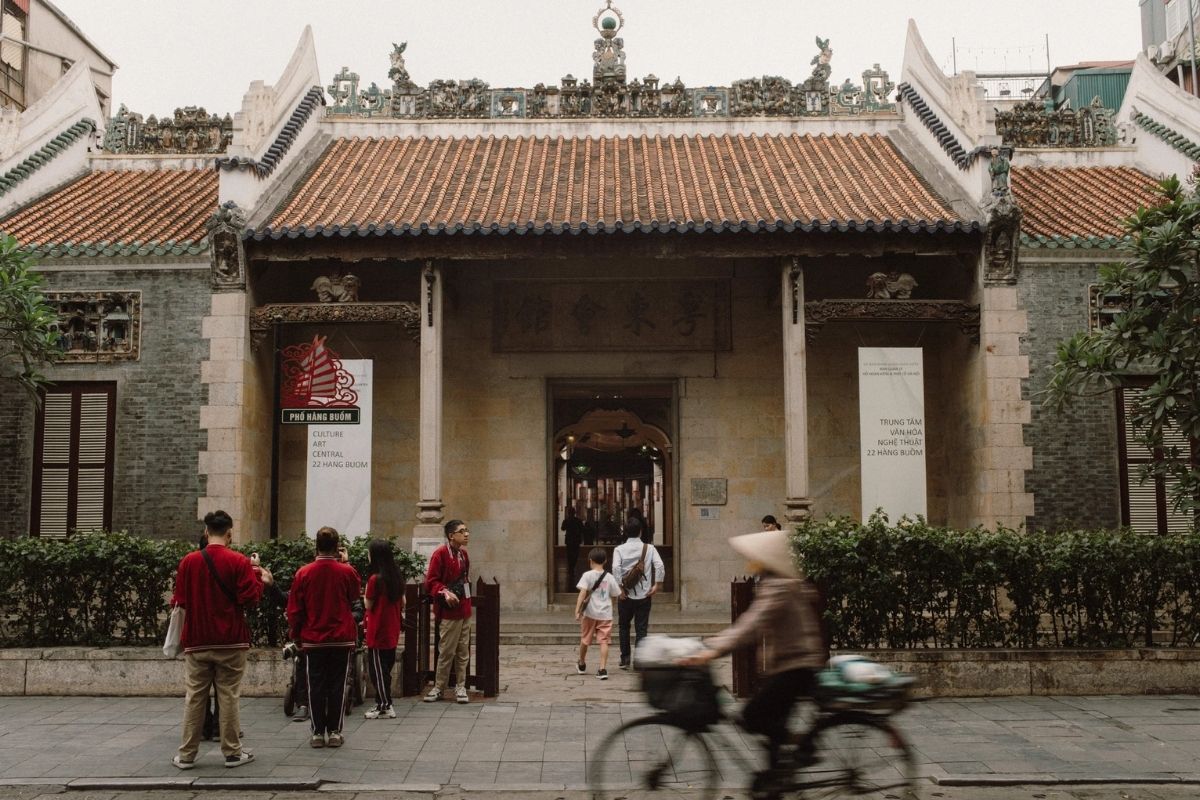
Quang Dong Assembly Hall (Source: migo)
Shopping in Hanoi Chinatown: Souvenirs and Traditional Goods
Shopping in Hanoi Chinatown, Hanoi is itself an experience, where you can shop for a variety of traditional Chinese items ranging from herbal medicines to special souvenirs:
- Chinese Herbal Medicine on Lan Ong Street:
- Top Shops: Thien Thanh Herbal Medicine Shop at 25 Lan Ong Street and Phuc Loc Tho Herbal House at 32 Lan Ong Street.
- What to Buy: Dried herbs, medicinal roots, herbal teas, and traditional Chinese remedies
- Price Range: 50,000 – 500,000 VND, depending on the type of herbs.
- Traditional Chinese Tea and Silk:
- Where to Buy: Thu Hien Silk Shop at 58 Hang Ngang Street for high-end silk, and Hao Hong Tea Shop at 40 Hang Buom Street, Hanoi, for Chinese teas such as Pu-erh and Oolong.
- Price Range: From 150,000 VND for silk scarves to 80,000 VND per pack for tea.
- Chinese Pastries and Candies:
- Where to Buy: Ngan Phuong Bakery, 65 Hang Buom Street Hanoi
- Popular Items: mooncakes, sesame candies, peanut brittle.
- Price Range: 20,000 – 100,000 VND per pack.
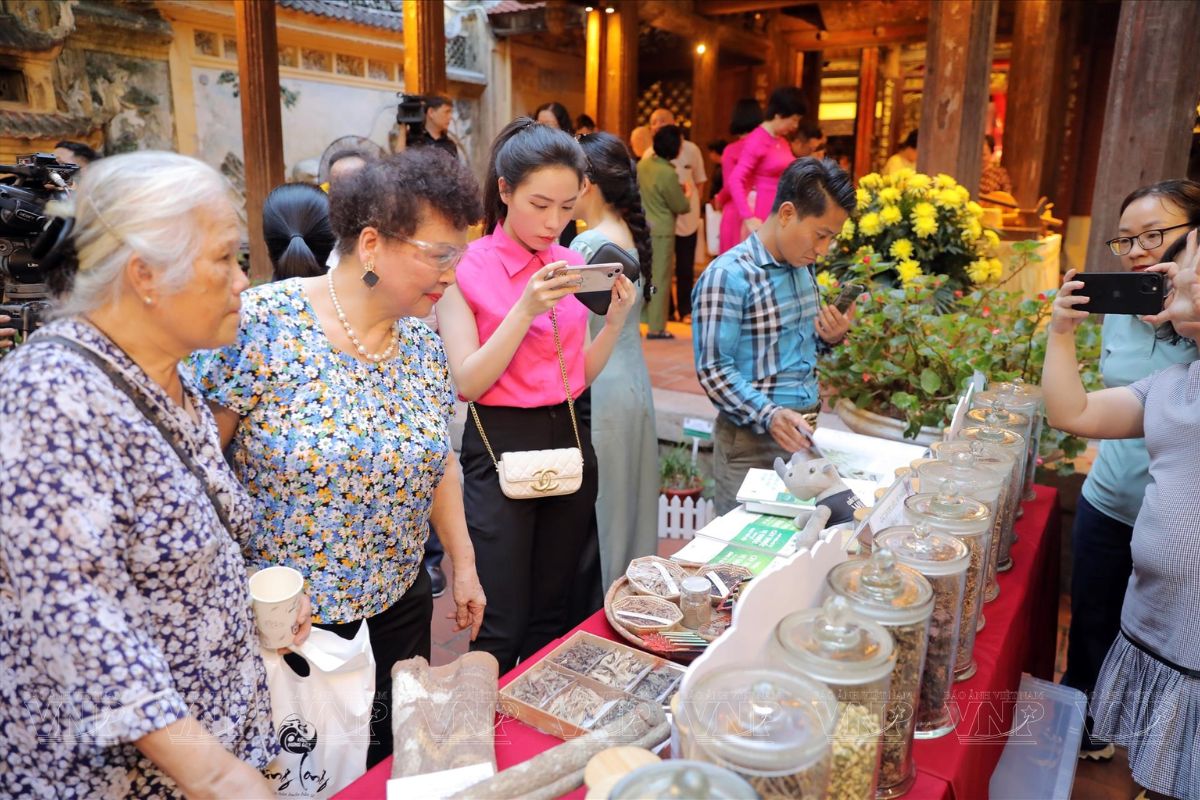
Chinese Herbal Medicine on Lan Ong Street (Source: vnanet)
Nightlife and Street Food: Experience Hanoi Chinatown After Dark
As the day closes, Hanoi Chinatown becomes a bustling night market full of tasty street food stalls, glowing lights, and a vibrant atmosphere:
- Explore the Night Food Market on Hang Buom Street Hanoi:
- Sample freshly grilled skewered items, fried dumplings, and Chinese-style spring rolls.
- Indulge in a cool glass of chrysanthemum tea or other herbal beverages.
- Price Range: 10,000 – 50,000 VND per dish.
- Late-Night Dining at Little Hong Kong:
- Location: 75 Hang Buom Street Hanoi.
- Indulge in an array of dim sum and roasted dishes well past nightfall
- Price: 40,000 – 150,000 VND per dish.
- Rooftop Views at Lan Ong Tea House:
- Location: 50 Lan Ong Street, Hanoi Chinatown.
- Drink traditional Chinese tea while looking over the crowded streets below.
- Price: 30,000 – 80,000 VND per cup.
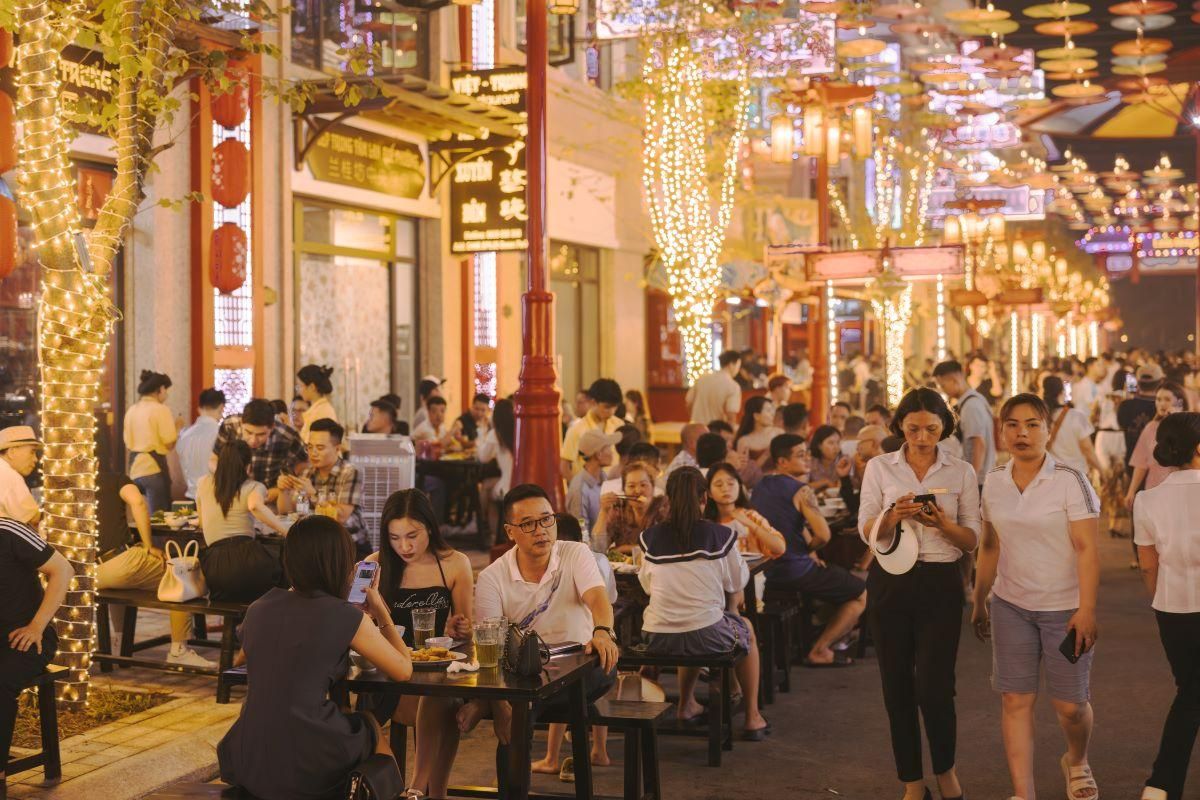
Late-Night Dining at Little Hong Kong (Source: kinhdoanhvaphattrien)
Practical Travel Tips for Visiting Hanoi Chinatown
Best Time to Visit Hanoi Chinatown
The best season to travel to Hanoi Chinatown is from October to April, when the weather is cool and agreeable, so that you can enjoy the lively streets of Hanoi 36 Streets to the fullest. But if you wish to enjoy the district in the most vibrant state, then travel to Hanoi Chinatown around these special events:
- Lunar New Year (Tet Festival): Usually occurring in late January or early February, Hanoi Chinatown is vibrantly awakened to the sight of colored decor, bustling markets, and traditional lion dances along Hang Buom Street Hanoi. The shops are open to the seasonal treats, and the whole area is covered in red lanterns.
- Mid-Autumn Festival: September is the time for the Mid-Autumn Festival, a time to spend in Hanoi Chinatown, where there are lanterns, mooncakes, and cultural performances. Do not pass up visiting Ngan Phuong Bakery at Hang Buom Street Hanoi, to taste the legendary mooncakes.
- Other Recommended Months: March and April have sunny skies with moderate weather, ideal for walking tours and picture-taking.
How to Respect Local Culture in Hanoi Chinatown
Hanoi Chinatown is a culturally and religiously significant area, home to ancient temples, assembly halls, and religious sites. To have a respectful and enjoyable experience, observe these cultural etiquette rules:
- Respect Religious Sites: It is best to dress modestly for visits to other temples, such as the Quang Dong Assembly Hall at 22 Hang Buom Street Hanoi, or the Fujian Assembly Hall at 40 Lan Ong Street. Remove the hat and keep the voice down.
- Photography Etiquette: As much as you may want to capture every lovely aspect, always request permission before photographing the locals, in particular in temples or assembly halls. Do not use a flash in religious places.
- Mind Your Behavior in Temples: Mind Your Manners in Temples: Don’t touch religious statues or altars, or offerings. Donations should be discreetly put inside the donation box without drawing attention to them.
- Respect Local Customs: When purchasing herbal medicines along Lan Ong Street or trying Chinese-style banh mi, always be courteous, smile, and thank vendors. It is helpful to learn a few Vietnamese salutations, such as “Xin chao" (Hello) and “Cam on" (Thank you).
Safety Tips for Exploring Hanoi Chinatown
Although Hanoi Chinatown is generally a friendly and secure place to tour, observing these few rules of thumb will guarantee a trouble-free visit:
- Avoid Crowds During Peak Hours: Hang Buom Street Hanoi, Lan Ong, and Hang Ngang are some of the busiest streets. Go there early in the morning or late afternoon for a relaxing experience.
- Beware of Pickpockets: As with most populated sites, keep valuables close to you. Wear a crossbody bag or keep valuables away from back pockets.
- Dealing with Street Vendors: Vendors in Hanoi Chinatown are generally friendly, but always check the price before ordering food or purchasing souvenirs. Bargaining is acceptable, but always be courteous.
- Stay Hydrated: Walking around the crowded streets can be exhausting, even at the height of summer. Take a break at a local tea house along Lan Ong Street to relax with a refreshing herbal drink.
Conclusion
Hanoi Chinatown is a historical, cultural, and gastronomic fusion of ancient temples, lively streets, and mouthwatering Chinese-style banh mi, coming together in the center of Hanoi 36 Streets. From wandering Hang Buom Street Hanoi to visiting traditional herbal stores on Lan Ong, there are stories just waiting to be uncovered around every bend. Are you ready for the experience of a lifetime? Reserve a guided tour with Impress Travel for an insider’s experience of Hanoi Chinatown. Your journey starts now!







